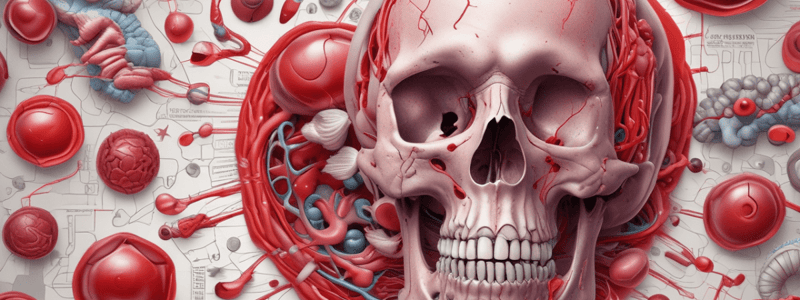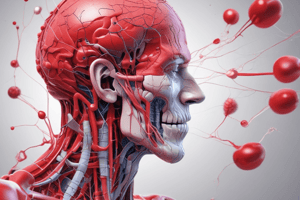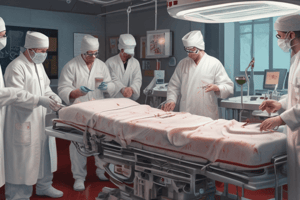Podcast
Questions and Answers
What is the primary function of the pancreas?
What is the primary function of the pancreas?
The pancreas aids in digestion and blood sugar regulation, and is part of the endocrine system, producing insulin.
What is the role of the left ventricle of the heart?
What is the role of the left ventricle of the heart?
The left ventricle is the strongest section of the heart and is responsible for pumping oxygenated blood to the body.
What is the difference between systolic and diastolic blood pressure?
What is the difference between systolic and diastolic blood pressure?
Systolic pressure is the pressure during the contraction of the heart, while diastolic pressure is the pressure during the relaxation of the heart.
What is the main cause of atherosclerosis?
What is the main cause of atherosclerosis?
What is the main symptom of emphysema?
What is the main symptom of emphysema?
What is the main difference between hyperglycemia and hypoglycemia?
What is the main difference between hyperglycemia and hypoglycemia?
What is the process of moving air in and out of the lungs called?
What is the process of moving air in and out of the lungs called?
Name the three bones that make up the pelvic area.
Name the three bones that make up the pelvic area.
What is the normal respiratory rate for an infant in breaths per minute?
What is the normal respiratory rate for an infant in breaths per minute?
What does the abbreviation HIPAA stand for?
What does the abbreviation HIPAA stand for?
What is the legal requirement to perform care called?
What is the legal requirement to perform care called?
What part of the nervous system consists of the brain and spinal cord?
What part of the nervous system consists of the brain and spinal cord?
What is the mechanism of injury/illness in patients?
What is the mechanism of injury/illness in patients?
When considering stabilization of the spine, what intervention is typically used?
When considering stabilization of the spine, what intervention is typically used?
What are the main components of blood?
What are the main components of blood?
What is the purpose of white blood cells?
What is the purpose of white blood cells?
What is the significance of skin being pale in a patient?
What is the significance of skin being pale in a patient?
What does cyanosis around the lips and finger nail beds indicate?
What does cyanosis around the lips and finger nail beds indicate?
What is the purpose of red blood cells?
What is the purpose of red blood cells?
What is the process of breathing in called?
What is the process of breathing in called?
Describe the significance of flushing in a patient.
Describe the significance of flushing in a patient.
What is the process of breathing out called?
What is the process of breathing out called?
What does a jaundiced skin color indicate?
What does a jaundiced skin color indicate?
What is aspiration?
What is aspiration?
What is the main responsibility of an EMR (Emergency Medical Responder) when arriving at the scene?
What is the main responsibility of an EMR (Emergency Medical Responder) when arriving at the scene?
Explain the difference between cover and concealment in a tactical situation.
Explain the difference between cover and concealment in a tactical situation.
Name the five stages of grief and the order in which they occur.
Name the five stages of grief and the order in which they occur.
What are the contraindications for using a nasopharyngeal airway (NPA)?
What are the contraindications for using a nasopharyngeal airway (NPA)?
Describe the difference between the somatic and autonomic nervous systems.
Describe the difference between the somatic and autonomic nervous systems.
What are the four main components of blood, and briefly describe their functions?
What are the four main components of blood, and briefly describe their functions?
Where does the exchange of gases, nutrients, and waste occur in the cardiovascular system?
Where does the exchange of gases, nutrients, and waste occur in the cardiovascular system?
What type of arteries are small arteries connected to capillaries?
What type of arteries are small arteries connected to capillaries?
What is a sign of death characterized by stiffening of muscles or joints?
What is a sign of death characterized by stiffening of muscles or joints?
What are the superior chambers of the heart called?
What are the superior chambers of the heart called?
Which vessels carry blood back to the heart in the cardiovascular system?
Which vessels carry blood back to the heart in the cardiovascular system?
In what age classification does adolescence fall in CPR guidelines?
In what age classification does adolescence fall in CPR guidelines?
Which of the following is the correct definition of the term 'standard of care'?
Which of the following is the correct definition of the term 'standard of care'?
What is the main function of the pancreas?
What is the main function of the pancreas?
Which of the following is NOT one of the stages of grief as described in the text?
Which of the following is NOT one of the stages of grief as described in the text?
Which chamber of the heart is responsible for pumping deoxygenated blood to the lungs?
Which chamber of the heart is responsible for pumping deoxygenated blood to the lungs?
What is the main difference between an EMR (Emergency Medical Responder) and an EMT (Emergency Medical Technician)?
What is the main difference between an EMR (Emergency Medical Responder) and an EMT (Emergency Medical Technician)?
What is the term for the condition that prevents a patient from producing insulin?
What is the term for the condition that prevents a patient from producing insulin?
What does thready pulse indicate in a patient?
What does thready pulse indicate in a patient?
What is the primary function of red blood cells?
What is the primary function of red blood cells?
What is the main difference between cover and concealment in a tactical situation?
What is the main difference between cover and concealment in a tactical situation?
What is the main cause of atherosclerosis?
What is the main cause of atherosclerosis?
What is the primary function of white blood cells?
What is the primary function of white blood cells?
Which respiratory disease is caused by smoking and results in the breakdown of alveoli?
Which respiratory disease is caused by smoking and results in the breakdown of alveoli?
What term refers to low oxygen levels within the body?
What term refers to low oxygen levels within the body?
Which vessels carry blood back to the heart?
Which vessels carry blood back to the heart?
What is the main component of blood where exchanges of gases, nutrients, and wastes occur?
What is the main component of blood where exchanges of gases, nutrients, and wastes occur?
Which area of bones consists of illium, ischium, and pubis?
Which area of bones consists of illium, ischium, and pubis?
What is the legal requirement to perform care called?
What is the legal requirement to perform care called?
What is the main cause of seizures in children and infants, as mentioned in the text?
What is the main cause of seizures in children and infants, as mentioned in the text?
What type of muscle is the diaphragm?
What type of muscle is the diaphragm?
What is the function of ligaments in the body?
What is the function of ligaments in the body?
Which of the following indicates incomplete combustion and is smokeless and odorless?
Which of the following indicates incomplete combustion and is smokeless and odorless?
What is the function of tendons in the body?
What is the function of tendons in the body?
Flashcards are hidden until you start studying
Study Notes
Anatomy and Physiology
- The Peripheral Nervous System (PNS) consists of all nerves outside the Central Nervous System (CNS)
- The Pancreas aids in digestion and blood sugar regulation, producing insulin as part of the endocrine system
- The Heart:
- Left Ventricle: strongest section, responsible for blood flow to the body
- Right Ventricle: pumps deoxygenated blood to the lungs
- Left Atrium: receives oxygenated blood from the lungs
- Right Atrium: receives deoxygenated blood
- Blood vessels:
- Arteries: carry blood away from the heart
- Veins: carry blood back to the heart
- Capillaries: thin blood vessels where gas, nutrient, and waste exchange occurs
Cardiovascular System
- Systolic pressure: pressure of the contraction of the heart
- Diastolic pressure: pressure of the relaxation of the heart
- Thready pulse: difficult to feel, indicates cardiogenic shock or cardiac arrest
- Atherosclerosis: build-up of fats, cholesterol, and substances in artery walls, causing obstruction of blood flow
- Congestive Heart Failure (CHF): caused by fluid backup in the lungs due to the heart's inability to pump properly
Respiratory System
- Dyspnea: difficult or labored breathing
- Emphysema: respiratory disease caused by smoking, resulting in breakdown of alveoli
- Pulmonary Ventilation: process of moving air in and out of the lungs
Nervous System
- Central Nervous System (CNS): consists of the brain and spinal cord
- Peripheral Nervous System (PNS): contains nerves that transmit messages to and from the CNS
- Bones in the pelvic area: ilium, ischium, and pubis (33 bones)
Medical Emergencies
- Abdominal Aortic Aneurysm (AAA): enlargement of the aorta, main blood vessel delivering blood to the body
- Hypoxia: low oxygen levels in the body
- Cyanosis: blueness or lividness of the skin
- Hyperglycemia: high blood sugar/glucose
- Hypoglycemia: low blood sugar/glucose
- Diabetic emergency: condition preventing patient from producing insulin
Patient Assessment
- Chief Complaint: main issue the patient is experiencing
- Nature of Injury (NOI)
- HIPAA: Health Insurance Portability and Accountability Act
- Standard of Care: degree of care a prudent and reasonable person would exercise in the same circumstance
- Negligence: failure to follow a standard of care
- Abandonment: leaving a patient without turning them over to a higher level of care
- Duty to act: legal requirement to perform
Pediatrics
- Respiratory Rate for Infant: 30-60 bpm
Seizures
- Treatment: let patient finish, then consider ABC and place in a recovery position and transport ASAP
Poisoning
- Any substance that can harm the body
- Ingested: through mouth
- Inhalation: through respiratory tract
- Injection: through skin or puncture
Miscellaneous
- Redirection: brings patient's focus back to the topic or attention to the immediate situation or crisis
- Jaw thrust maneuver: used in suspected spinal injury
Studying That Suits You
Use AI to generate personalized quizzes and flashcards to suit your learning preferences.




